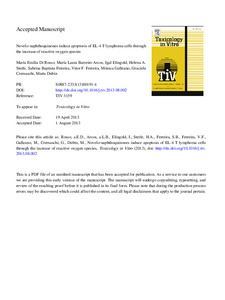Por favor, use este identificador para citar o enlazar este ítem:
https://repositorio.uca.edu.ar/handle/123456789/8780| Título: | Novel o-naphthoquinones induce apoptosis of EL-4 T lymphoma cells through the increase of reactive oxygen species | Autor: | Di Rosso, María Emilia Barreiro Arcos, María Laura Elingold, Igal Sterle, Helena Andrea Baptista Ferreira, Sabrina Ferreira, Vitor Francisco Galleano, Mónica Cremaschi, Graciela A. Dubin, Marta |
Palabras clave: | APOPTOSIS; BENZODIAZEPINAS; OXIGENO; IONES; RADICALES LIBRES; CELULAS | Fecha de publicación: | 2013 | Editorial: | Elsevier | Cita: | Di Rosso ME, Barreiro Arcos ML, Elingold I, et al. Novel o-naphthoquinones induce apoptosis of EL-4 T lymphoma cells through the increase of reactive oxygen species [en línea]. Postprint del artículo publicado en Toxicology in Vitro. 2013;27(7):2094-2104. doi:10.1016/j.tiv.2013.08.002 Disponible en: https://repositorio.uca.edu.ar/handle/123456789/8780 | Resumen: | Abstract: Novel β-lapachone analogs 2-phenyl-3,4-dihydro-2H-benzo[h]chromene-5,6-dione (NQ1), 2-p-tolyl-3,4-dihydro-2H-benzo[h]chromene-5,6-dione (NQ3) and 2-methyl-2-phenyl-3,4-dihydro-2H-benzo[h]chromene-5,6-dione (NQ7), which have trypanocidal activity, were assayed for cytotoxic effects on murine EL-4 T lymphoma cells. The NQs inhibited the proliferation of EL-4 cells at concentrations above 1μM. Nuclear staining of the EL-4 cells revealed chromatin condensation and a nuclear morphology compatible with the induction of apoptosis. Flow cytometry assays with annexin V-FITC and propidium iodide confirmed the cell death by apoptosis. Using electron paramagnetic resonance (EPR), a semiquinone radical was detected in EL-4 cells treated with NQs. In addition, a decrease in the GSH level in parallel with reactive oxygen species (ROS) production was observed. Preincubation with n-acetyl-l-cysteine (NAC) was able to reverse the inhibitory effects of the NQs on cell proliferation, indicating that ROS generation is involved in NQ-induced apoptosis. In addition, the NQs induced a decrease in the mitochondrial membrane potential and increased the proteolytic activation of caspases 9 and 3 and the cleavage of Poly (ADP-Ribose) Polymerase (PARP). In conclusion, these results indicate that redox cycling is induced by the NQs in the EL-4 cell line, with the generation of ROS and other free radicals that could inhibit cellular proliferation as a result of the induction of the intrinsic apoptosis pathway. | URI: | https://repositorio.uca.edu.ar/handle/123456789/8780 | ISSN: | 0887-2333 (impreso) 1879-3177 (online) |
Disciplina: | MEDICINA | DOI: | 10.1016/j.tiv.2013.08.002 | Derechos: | Acceso abierto | Fuente: | Toxicology in Vitro. 2013;27(7):2094-2104 |
| Aparece en las colecciones: | Artículos |
Ficheros en este ítem:
| Fichero | Descripción | Tamaño | Formato | |
|---|---|---|---|---|
| novel-o-naphthoquinones-induce-apoptosis.pdf | 848,58 kB | Adobe PDF |  Visualizar/Abrir |
Visualizaciones de página(s)
286
comprobado en 09-ene-2026
Descarga(s)
209
comprobado en 09-ene-2026
Google ScholarTM
Ver en Google Scholar
Altmetric
Altmetric
Este ítem está sujeto a una Licencia Creative Commons

